

 Share This Page
Share This Page| Home | | Sailing | | Alaska 2012 | |  |  |  Share This Page Share This Page |
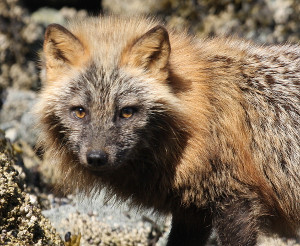
Copyright © 2012, P. Lutus. All rights reserved. Message Page
| Prior years: |
Alaska 2002 |
Alaska 2003 |
Alaska 2004 |
Alaska 2005 |
Alaska 2006 Alaska 2007 | Alaska 2008 | Alaska 2009 | Alaska 2010 | Alaska 2011 |
(double-click any word to see its definition)
The title says it all. While in Alaska I meet any number of cute animals doing all sorts of insufferably cute things, or getting into fixes that are more than a little funny, or performing an animal version of a Keystone Cops routine, or all of the above.
Blind Porcupine
One day I decided to kayak up Duncan Canal, west of Petersburg in the southeast. This was a new territory for me, and it looked like an interesting kayak paddle. To me, an "interesting kayak paddle" is usually a long stretch of water in some kind of narrow channel, so the waves can't easily get large and one's chances of being upended in the middle of a big bay aren't too great. It can't hurt if there's interesting landscape and wildlife.
The northernmost part of Duncan Canal meets these requirements. I anchored the big boat at about 56° 46.83' N, 133° 16.84' W, launched my kayak from there, and paddled north into a narrow, relatively shallow area that turned out to be very interesting.
So I'm paddling along, enjoying the view, when a porcupine decides to cross the canal, perpendicular to my course. Oblivious to my presence, he dives into the water, swims out, and crashes into my kayak. I don't normally yell at animals — I regard it as bad form as well as an example of species elitism. But I couldn't help myself — I said, "Hey porcupine! Are you blind?"
The porcupine, who turned out to be in fact nearly blind, slowly turned around, swam back to the shore, shook himself off, and wandered off with an air of ... well ... something between annoyance at the human intruder, and perfect indifference.

Definitely an annoyed look
|
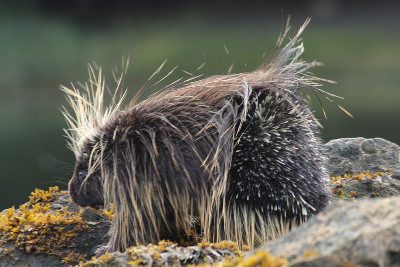
Based on the missing quills, this porcupine
is well past middle age |
The funniest moment of the day was when Mr. Porcupine shook himself off. This picture might convey a bit of how funny it was:
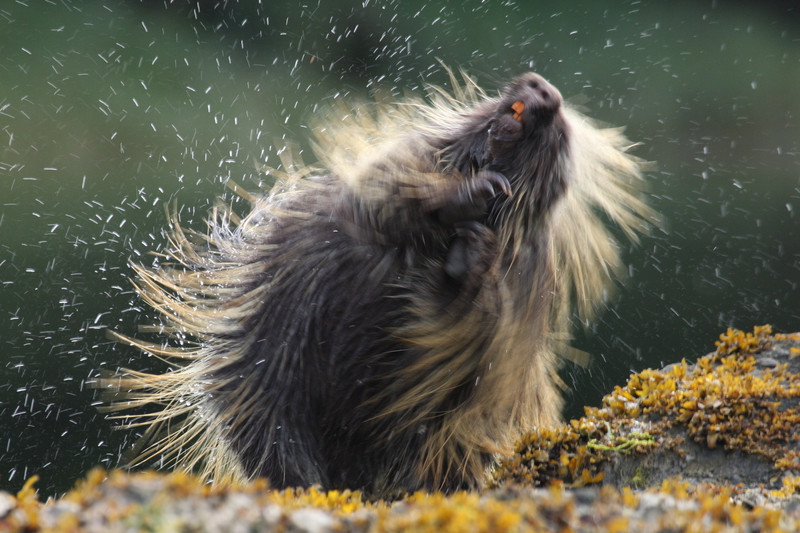
Fighting Foxes
Earlier in the season I had visited Bluefox Bay on the west side of Afognak Island (part of the Kodiak Island group), and paddled my kayak out at low tide to see if I might meet some interesting wildlife.
I've written about Alaskan foxes before — I think they're a lot of fun, and beautiful as well. As I paddled north from Bluefox Bay, I realized I was close to the time of low tide for the day, and the tide was quite low (minus 0.8 feet).
A word of explanation. There are two varieties of fox commonly seen in Alaska, Red Fox (Vulpes vulpes) and Blue or Arctic Fox (Vulpes lagopus). Here are pictures of each species from my image collection:
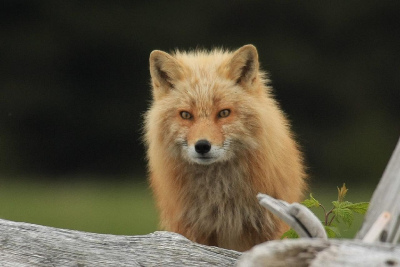
A: Red Fox (Vulpes Vulpes)
(Cick image for larger size) |
B: Blue/Arctic Fox (Vulpes lagopus), summer coloring
|
Arctic foxes are only sometimes the color seen in image (B) above. Those that live farther north tend to be white for most of the year. But there's more — in Alaska, Red and Blue foxes interbreed, I have seen the result, and here it is:
C: Cross-breed red/blue fox, seen 6.19.2012 at Bluefox Bay, Afognak Island
As they got closer together, the two foxes began growling, then they started to fight — the cross-breed leapt forward and pushed the blue fox onto the ground, and both foxes bared their teeth in a threat display. I decided to try for a picture or two, so I paddled closer, got out my camera and started snapping away.
The reasons I was able to get close enough for detailed pictures were (a) the foxes were too busy fighting to notice much of anything else, and (b) the sun was behind me. But eventually they realized they were being observed, and the cross-breed fox panicked and took off:
|
This is my turf!
|
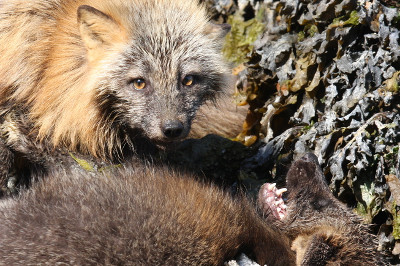
Hey — someone's watching us!
|
This was a new experience for me. I've seen bears do this — a female bear, especially one with cubs, will notice the male bears (the natural enemy of a female bear with cubs) run off at the approach of a human, draw a relatively complex conclusion, i.e. "The enemy of my enemy is my friend", and resolve to stick close to humans after that (see below). But this was the first time I've seen it with foxes.
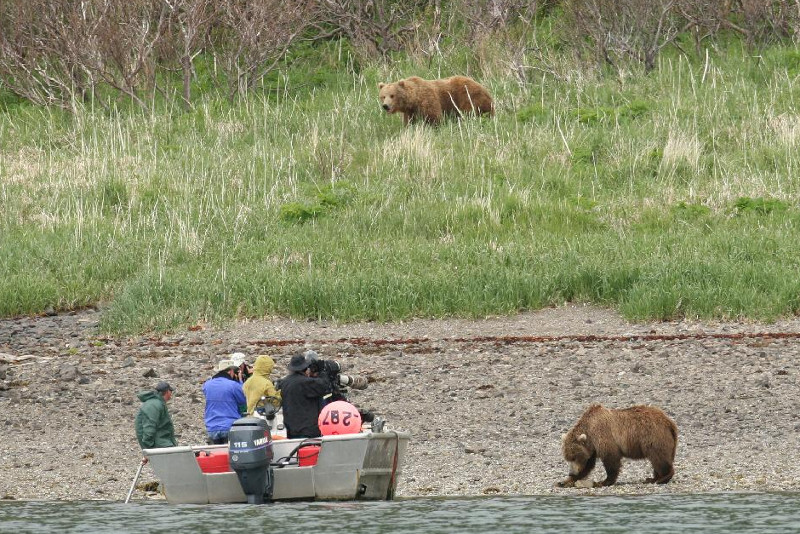
inimicus inimici mei amicus meus est (The enemy of my enemy is my friend)
| Home | | Sailing | | Alaska 2012 | |  |  |  Share This Page Share This Page |